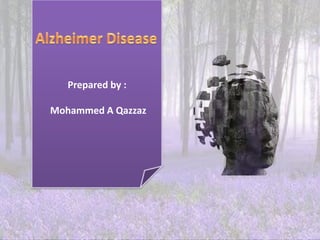
Alzheimer disease
- 1. Prepared by : Mohammed A Qazzaz
- 2. In 1906 Dr. Alois Alzheimer was first to describe Alzheimer's illness. A progressive, degenerative illness that attacks the brain and results in impaired memory, thinking and behavior.
- 3. Memory loss that affects job skills. Difficulty performing familiar tasks. Problems with language . Disorientation to time and place. Poor or decreased judgment. Problems with abstract thinking. Misplacing things . Changes in mood or behavior. Changes in personality.
- 4. Forgetfulness . Social withdrawal . Hallucinations . Seizures . Death usually result from malnutrition , infection , heart disease
- 5. AD is a pan ethnic , genetically heterogeneous disease Less than 5% of patients have an early-onset familial disease , 15-25% of patients have a late-onset familial disease and 75% of patients have a sporadic disease . 10% of familial AD exhibits autosomal dominant inheritance ; the reminder exhibits multifactorial inheritance .
- 6. Early-onset AD is a rare form of AD, affecting only about 5 percent of all people who have AD. It develops in people ages 30 to 60. FAD is caused by a number of different gene mutations on chromosomes 21, 14, and 1, and each of these mutations causes abnormal proteins to be formed.
- 7. Mutations on chromosome 21 cause the formation of abnormal amyloid precursor protein (APP). A mutation on chromosome 14 causes abnormal presenilin 1 to be made, and a mutation on chromosome 1 leads to abnormal presenilin 2.
- 8. Even if only one of these mutated genes is inherited from a parent, the person will almost always develop early-onset AD. This inheritance pattern is referred to as “autosomal dominant” inheritance. In other words, offspring in the same generation have a 50/50 chance of developing FAD if one of their parents had it.
- 9. developing after age 60. genetics of AD have found that the mutations seen in early-onset AD are not involved in this form of the disease. Both familial AD and sporadic late-onset AD are strongly associated with Apo lipoprotein E (APOE) gene found on chromosome 19 APOE comes in several different forms, or alleles. Three forms—APOE ε2, APOE ε3, and APOE ε4—occur most frequently.
- 10. APOE ε4 occurs in about 40 percent of all people who develop late-onset AD. and is present in about 25 to 30 percent of the population. People with AD are more likely to have an APOE ε4 allele than people who do not develop AD. However, many people with AD do not have an APOE ε4 allele.
- 11. APP undergoes endoproteolytic cleavage in the to produce a peptide of 40 amino acid (Aβ40) the function of Aβ40 is unknown . In contrast , cleavage of APP in the endoplasmic reticulum produce a peptide of 42 or 43 Amino acid (Aβ42/ Aβ43) .and its neurotoxic substance .
- 12. Patients with AD have a significant increase in (Aβ42/ Aβ43) aggregates within the brain Mutation in APP PSEN1 and PSEN2 increase the production of (Aβ42/43) . 1% of all AD cases occur in patients with down syndrome . Who overexpress APP. The role of ε4 is unclear .
- 13. Cortical atrophy . Neurodegeneration in cholinergic neurons of hippocampus . Extracellular neuritic plaques . Intraneuronal neurofibrillary tangles . Amyloid deposits in the wall of cerebral arteries .
- 14. An AD plaque An AD tangle
- 15. Beta-amyloid Plaques Amyloid precursor protein (APP) is the precursor to amyloid plaque. 1. APP sticks through the neuron membrane. 2. Enzymes cut the APP into fragments of protein, including beta- amyloid. 3. Beta-amyloid fragments come together in clumps to form plaques.
- 17. Mutation in PSEN1 are fully penetrant and usually cause rapidly progressive disease with mean onset at 45 . Mutation in APP are fully penetrant and usually cause a rate of AD progression similar to that of late-onset AD with range onset of 45 to 75 . Mutation in PSEN2 are not fully penetrant and usually cause slowly progressive disease with onset ranging from 40 to 57 .
- 18. Increase the cholinergic activity •cholesterol-lowering drugs •anti-oxidants (vitamins) and folic acid •anti-inflammatory drugs •substances that prevent formation of beta-amyloid plaques •nerve growth factor to keep neurons healthy
- 19. Old age Family history Female gender Down syndrome
